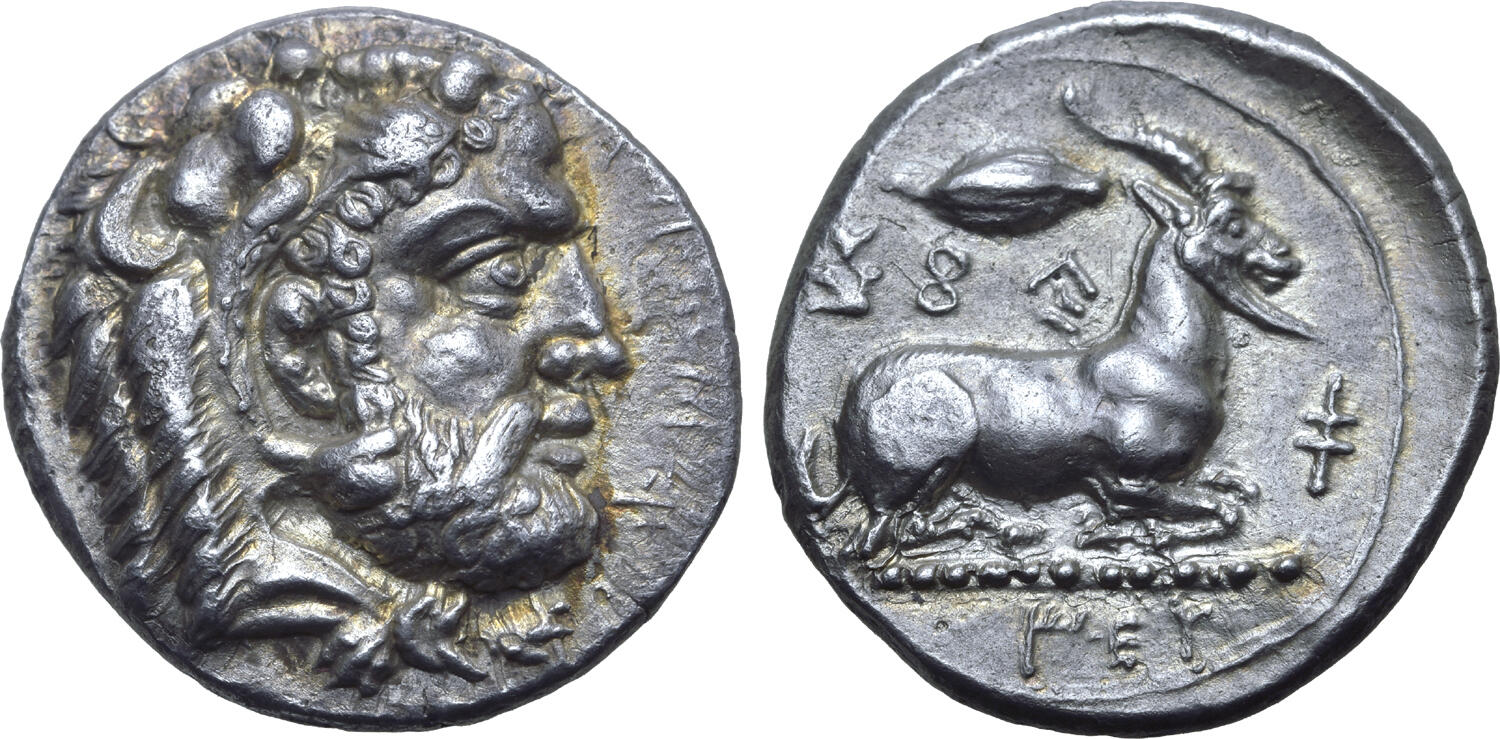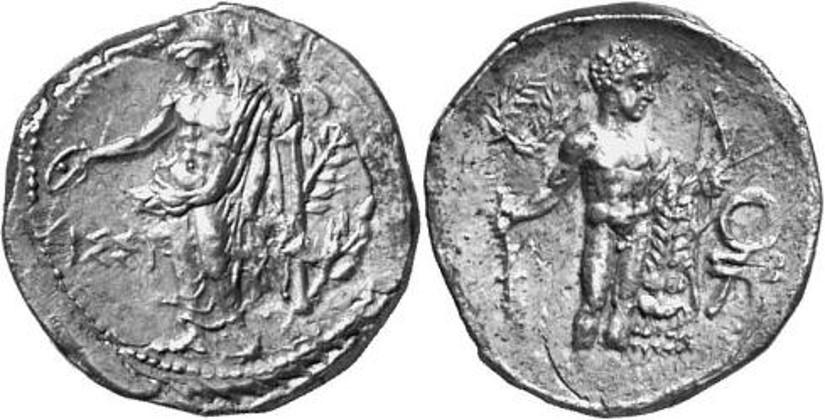2388 - Issus (double siglos Apollo/Heracles) over Salamis (Heracles/ram) (Gorny & Mosch, 142, Oct. 2005, 1593)
From SILVER
410 BCE - 390 BCEΙΣΣΙ
Images
Overstruck variety

Salamis_Heracles_ram.jpg [1]
Location/history
| Sale(s)Sale(s) ᵖ: | Gorny & Mosch, 142, 10 Oct. 2005, 1593 | |
Overstriking coin
Description
| ObverseInscription or printing placed on the obverse.: | ΙΣΣΙ (Greek) Apollo standing left, holding a patera and resting against laurel tree. Border of dots. | ReverseInscription or printing placed on the reverse.: | Herakles standing right, holding club, bow, arrow and lion’s skin. In upper left field, wreath. In lower field right, ankh. |
Mint and issuing power
| MintIdentifies the place of manufacture or issue of a numismatic object.: | Issus | Ancient regionAncient region. | Cilicia | Modern countryModern country: Turkey | AuthorityIdentifies the issuing power. The authority can be "pretended" when the name or the portrait of X is on the coin but he/she was not the issuing power. It can also be "uncertain" when there is no mention of X on the coin but he/she was the issuing power according to the historical sources: | Persian Empire |
Chronology
| FromIdentifies the initial date in a range assigned in a numismatic context. 410 BCE toIdentifies the final date in a range assigned in a numismatic context.. 390 BCE | Classical 480-323 BC |
Physical description
| MetalThe physical material (usually metal) from which an object is made.: Silver |
WeightWeight of the numismatic object (in grams). in grams: 10.4710.47 g <br />10,470 mg <br /> | DenominationTerm indicating the value of a numismatic object. Examples: tetradrachm, chalkous, denarius.: double siglos |
|
| StandardStandard.: Persian | |||
References
| Coin referenceReference of the Coin: | Callataÿ 2018b, p. 143, n° 25 | Coin series referenceReference to coin series study: | Callataÿ 2018b1Callataÿ 2018b, p. 143, n° 25 |
| Coin series web referenceCoin series web references: | |||
Overstruck type
Description
| ObverseInscription or printing placed on the obverse.: | 'e-u-wa-ko-ro' in Cypriot script before (Cypriot) Head of bearded Herakles to right, wearing lion skin headdress | ReverseInscription or printing placed on the reverse.: | Cypriot script legend reading 'pa-si-le-wo-se' (Cypriot) Ram with long horns and beard lying to right on dotted ground line, barley-grain above, EY around. |
Mint and issuing power
| MintIdentifies the place of manufacture or issue of a numismatic object. ᵖ: | Salamis | Ancient regionAncient region. ᵖ | Cyprus | Modern countryModern country: Turkey | AuthorityIdentifies the authority in whose name (explicitly or implicitly) a numismatic object was issued. ᵖ: | Evagoras I (king of Salamis, 411-374 BC) |
Chronology
| FromIdentifies the initial date in a range assigned in a numismatic context. 411 BCE toIdentifies the final date in a range assigned in a numismatic context.. 374 BCE | Classical 480-323 BC |
Physical description
| DenominationTerm indicating the value of a numismatic object. Examples: tetradrachm, chalkous, denarius. ᵖ: | stater |
References
| Coin type referenceReference to coin series study ᵖ: | Zapiti - Michaelidou 20082Zapiti - Michaelidou 2008, n° 6 | ||
| Coin series web reference overstruckCoin series web references overstruck: | |||
Additional data
| Frequency of overstrikesFrequency of overstrikes: | rare and concentrated | Level of confidenceLevel of confidence of the identification: | sure |
| RemarksRemarks: | "overstruck on Salamis, c. 411-373 BC (obv.: head of Herakles r.; rev.: ram recumbent right on a dotted line)" | ||
References
- ^ Callataÿ, François de (2018), “Overstrikes on Pamphylian and Cilician silver sigloi (5th-4th c. BC)”, in O. Tekin (ed.), Proceedings of the Second International Congress of the Anatolian Monetary History and Numismatics in the Mediterranean World, 5-8 January 2017 Antalya, Antalya, 2018, p. 131-150.
- ^ Zapiti, Eleni - Michaelidou, Lefki (2008), Coins of Cyprus : from the collection of the Bank of Cyprus Cultural Foundation, Nicosia, Bank of Cyprus Cultural Foundation, 329 p.
